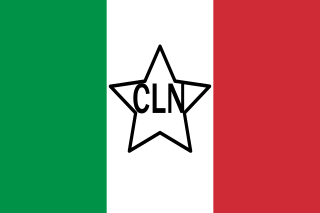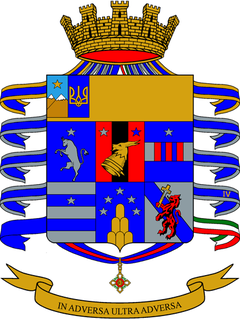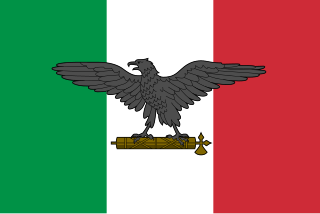
The Italian Social Republic, popularly and historically known as the Republic of Salò, was a German puppet state with limited recognition that was created during the later part of World War II, existing from the beginning of German occupation of Italy in September 1943 until the surrender of German troops in Italy in May 1945.

The Italian campaign of World War II, also called the Liberation of Italy, consisted of Allied and Axis operations in and around Italy, from 1943 to 1945. The Joint Allied Forces Headquarters (AFHQ) was operationally responsible for all Allied land forces in the Mediterranean theatre and it planned and led the invasion of Sicily in July 1943, followed in September by the invasion of the Italian mainland and the campaign in Italy until the surrender of the German Armed Forces in Italy in May 1945.

The Gothic Line was a German defensive line of the Italian Campaign of World War II. It formed Field Marshal Albert Kesselring's last major line of defence along the summits of the northern part of the Apennine Mountains during the fighting retreat of the German forces in Italy against the Allied Armies in Italy, commanded by General Sir Harold Alexander.

The Italian resistance movement is an umbrella term for Italian resistance groups during World War II. It was opposed to the forces of Nazi Germany as well as Nazi Germany's Italian puppet state regime, the Italian Social Republic, especially following the German invasion and military occupation of Italy between September 1943 and April 1945. Known as partisans, the brutal conflict they took part in is referred to as the Italian Liberation War or as the Italian Civil War. The modern Italian Republic was declared to be founded on the struggle of the Resistance.

The Alpini are the Italian Army's specialist mountain infantry. Part of the army's infantry corps, the speciality distinguished itself in combat during World War I and World War II. Currently the active Alpini units are organized in two operational brigades, which are subordinated to the Alpine Troops Headquarters. The Alpini's name comes from their inceptive association with the Alps, the mountain range that Italy shares with France, Switzerland, Austria, and Slovenia. An individual soldier of the Alpini is called Alpino.

The Royal Italian Army, also known as the Regio Esercito, was established during the proclamation of the Kingdom of Italy. During the 1800s Italy started to unify into one country and in 1861, Manfredo Fanti signed a creation decree which created the Army of the Two Sicilies. This newly created army first task was to defend against the repressive power in southern Italy. The Army of Two Sicilies combated against criminals and other armies during this time of unification. After the monarchy ended, the army changed its name to become the Italian Army.

The Italian Civil War was a civil war in Italy fought by the Italian Resistance and Italian Co-Belligerent Army against the Italian Fascists and Italian Social Republic from 9 September 1943 to 2 May 1945. The Italian Resistance and the Co-Belligerent Army also simultaneously fought against the Nazi German Army, which began occupying Italy immediately prior to the armistice and then invaded and occupied Italy on a larger scale after the armistice.

The 3rd Alpini Regiment is a regiment of the Italian Army's mountain infantry speciality, the Alpini, which distinguished itself in combat during World War I and World War II.

The 4th Alpini Paratroopers Regiment is a Ranger-type special forces regiment of the Italian Army, specializing in mountain combat. The regiment is one of four regiments of the Army Special Forces Command. The regiment is a unit of the Italian Army's mountain infantry speciality, the Alpini, which distinguished itself in combat during World War I and World War II. The 4th Alpini Regiment is one of the most decorated units of the Italian Army, although its two Gold Medals of Military Valour were awarded to the regiment's currently inactive Alpini Battalion "Aosta", respectively the currently active Skiers Battalion "Monte Cervino".

The 7th Alpini Regiment is a regiment of the Italian Army's mountain infantry speciality, the Alpini, which distinguished itself in combat during World War I and World War II.

The 1st Field Artillery Regiment (Mountain) is a field artillery regiment of the Italian Army, specializing in mountain combat. The regiment was raised in 1887 as Mountain Artillery Regiment to support the Italian Army's mountain infantry troops, the Alpini, with whom the regiment shares the distinctive Cappello Alpino. Both, the Alpini and the Mountain Artillery, distinguished themselves in World War I and World War II. The Gold Medal of Military Valour affixed to the regiment's war flag and displayed on the regiment's coat of arms was originally awarded to the Mountain Artillery Group "Aosta" for its service with the Partisan Division "Garibaldi" in Montenegro. Today the regiment is based in Fossano in Piedmont and operationally assigned to the Alpine Brigade "Taurinense".
Army Liguria was an army formed for the National Republican Army. The ENR was the national army of Italian dictator Benito Mussolini's Italian Social Republic. Formation of this RSI army started in 1943 and the army was disbanded in 1945. Army Group Liguria included several German units and its Italian units were sometimes transferred to German formations.

The National Republican Army was the army of the Italian Social Republic from 1943 to 1945 that fought on the side of Nazi Germany during World War II.
The 2nd 'Littorio' ("Lictor") Division was one of four divisions raised by Mussolini's Italian Social Republic. Although an infantry formation, it was often referred to as a "Grenadier" formation for morale purposes.

The Battle of Garfagnana, known to the Germans as Operation Winter Storm and nicknamed the "Christmas Offensive", was a successful Axis offensive against American forces on the western sector of the Gothic Line during World War II. It took place in December 1944 in the north Tuscan Apennines, near Massa and Lucca.

The Second Battle of the Alps was a military campaign fought between combined German and Italian Social Republic forces, and the re-established French Republic led by Charles de Gaulle.

The Alpini are a specialised mountain warfare infantry corps of the Italian Army, which distinguished itself in World War I fighting in the Alps against Austro-Hungarian Kaiserjäger and the German Alpenkorps. The Alpini were supported by the Mountain Artillery, which both share the Cappello Alpino as identifying symbol. Below follow tables listing the regiments, battalions and groups, companies and batteries of the Alpini and Mountain Artillery active in World War I.
The 3rd "San Marco" Marine Infantry Division was one of four divisions raised by Mussolini's Italian Social Republic. It existed from 26 November 1943 until 29 April 1945.
The 1st Bersaglieri 'Italia' Division was one of four divisions raised by Mussolini's Italian Social Republic. It existed from 25 November 1943 until 29 April 1945.
LXXV Army Corps was a corps in the German Army during World War II.
















